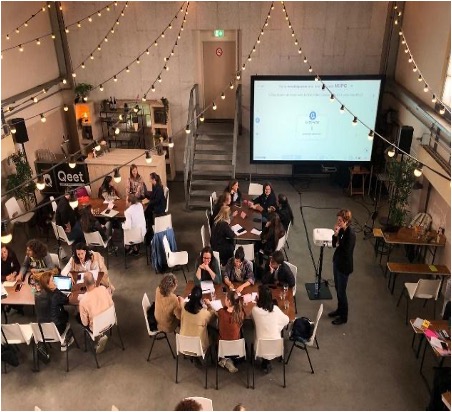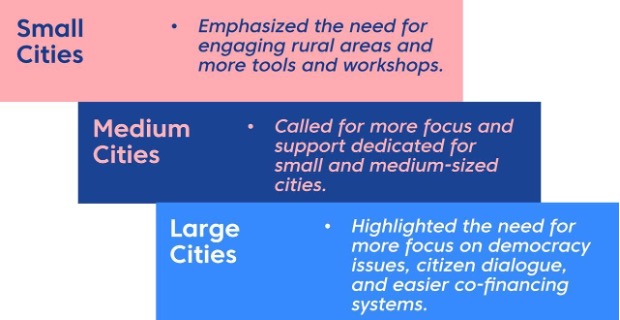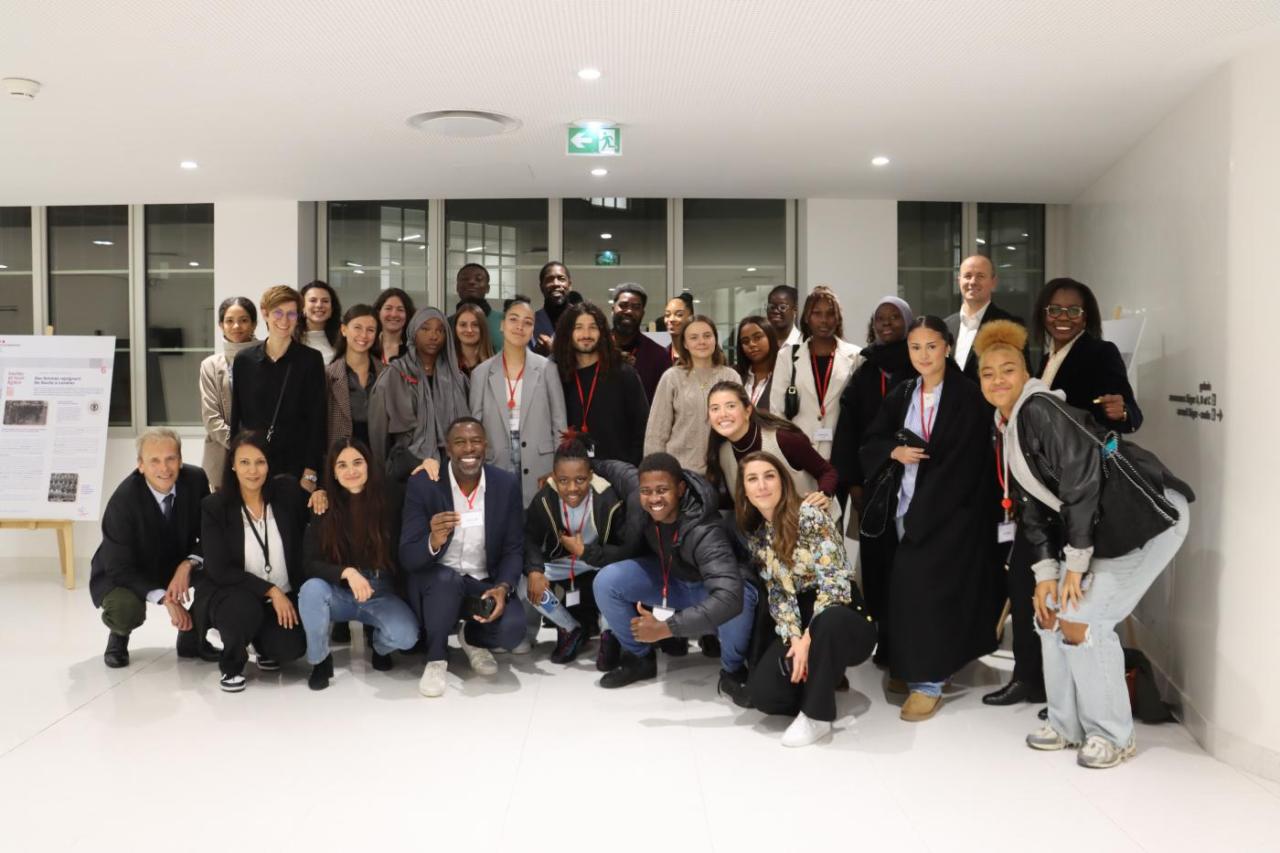EU Cohesion policy involves a myriad of local and regional actors, instruments, and communities. Consultations are a useful tool to ensure that these policies respond to the needs and realities of the people. In 2024, INTERREG launched a public consultation on the future Cohesion policy (post 2027). The European Commission provided a joint toolkit to support the collection of data and opinions within the specificities of each INTERREG programme.
Within this context, URBACT launched an online survey and consultation workshops. This was a cooperation exercise in itself, following the URBACT method’s integrated approach, strong participation, and co-creation and action learning. The consultation gathered valuable insights, based on two types of data: a) an online open survey with 228 respondents and b) 12 consultation workshops with different types of stakeholders and citizens (330 participants in total).
What are the main consultation findings and recommendations? What does the future hold for URBACT and cities in an ever-evolving policy and programme context?
Overview of main findings: European cities on urban cooperation
The consultation results were reviewed by a team of URBACT experts and consolidated in a final report approved by the URBACT Monitoring Committee.
The URBACT Harvesting Report (December 2024) formulates three key messages from URBACT for the future Cohesion policy:
1. Urban cooperation is key for cohesion and the European community. It creates a European identity and empathy between countries and cultures.
2. Urban cooperation is a long-term engagement of many partners that delivers strong responses to complex societal challenges.
3. Urban cooperation is a powerful movement that drives urban change for a better and future-oriented Europe.
The consultation reveals not only the main issues shaping our urban futures but also underscores URBACT’s particular contribution within the INTERREG framework and the post-2027 Cohesion policy framework. Let’s look closer at some of these findings and hear from different types of respondents!
Localised sustainable development
Whether the subject is green infrastructure, renewable energy, or sustainable mobility, the consultation revealed a strong focus on sustainable urban development across cities of all sizes.
Respondents also identified the need for more exchange and cooperation to advocate for cities’ needs and capacities. Among other key aspects, citizen participation and empowerment, integrated and strategic planning, localised SDGs and setting up effective local development processes were identified for requiring further attention within future territorial cooperation.
| « We need more help and involvement from our national authorities, more incentives to valuate good cooperation, and more advocacy for cities’ needs and capacities.» CITIZEN |
Learning and knowledge exchange
The consultation results indicate that cooperation between cities is appreciated for mutual learning and knowledge exchange through joint workshops, study visits, and exchanges. Small and medium-sized cities, especially, value such opportunities.
The consultations showed that small cities seek more direct incentives to evaluate and recognise good cooperation.
| « We learn from and with our European partner cities most effectively through joint workshops.» LOCAL AUTHORITY/CITY MUNICIPAL ADMINISTRATION |
Funding and financing
Funding and financing opportunities are valued across all regions and city sizes, with a specific focus on learning about new funding possibilities and how to approach them. This aspect was again particularly underlined by smaller and medium-sized cities.
| « We should reinforce the research for funding possibilities.» CITIZEN |
There is a clear consensus on the need for follow-up funding. City representatives expressed a strong desire to implement investment projects, including conversion of buildings, public spaces, restoration of cultural heritage and social facilities.
Achieving the digital transition
The digital transition was highlighted in responses, along with smart city development, and digital public services for citizen engagement.
Some suggested the use of digital tools and translation services to facilitate cross-border collaboration. Among smaller cities, in particular, project portals and online tools were identified as a means for improving information exchanges and efficiency.
« The European Union needs to pioneer more innovative, multi-sectoral, and daring initiatives instead of settling for business as usual.» PRIVATE SECTOR |
Calling on the voices of the future
Within this consultation, youth engagement had an important focus, given that they and future generations will be most affected by the long-term consequences of current policies.
In evaluating survey responses, the youth demonstrated high awareness of problems and good solutions in relation to different urban topics, especially the ones that affect them, such as mobility, safety, inclusive public spaces for culture and access to nature, climate change, poverty, gender inclusion, and mental health. They voiced their opinions and interest in peer-to-peer student exchanges, co-creating local solutions, and more opportunities to engage through cooperative platforms. The youth feedback and responses to this consultation showed that there is a great potential and importance for involving them in the integrated development of European cities.
« The city should offer more access to nature (e.g. make the Seine in Paris more accessible for pedestrians) and make this access to nature safe for everybody.» YOUTH |
Groups of young people participating in a consultation at the Agence nationale de la cohésion des territoires (ANCT) in Paris. Source: ANCT.
The URBACT experience through the looking glass
In evaluating the main consultation results, the Harvesting Report provides interesting first-hand accounts about the role of the URBACT programme in terms of furthering European cooperation.
« We learn good practices, know-how and methods for managing city centres from our European partners in the URBACT network.» NGO |
It was strongly underlined that participation in URBACT projects provided cities with increased visibility and access to additional funding opportunities beyond the project duration.
« URBACT was a springboard for my city to get visibility at the international stage and to receive other funding» CITY/LOCAL AUTHORITY |
The following sections elaborate on perceptions of the URBACT programme – today and tomorrow.
Benefits of cooperation
1. Involving citizens actively in the planning and implementation of projects to ensure that their voices are heard and their needs are met.
2. Validation of ideas seen in successful projects, such as URBACT Good Practices, is a pillar for bringing recognition of good ideas, which helps to convince local partners and policy makers (“It worked there, why shouldn’t we try it as well?!”).
...and many more…

The URBACT framework
Capacity building events for the city administration, including the URBACT Summer University and training on URBACT resources, are seen as great added value of URBACT for cities of all sizes.
Networking and dissemination activities stand as the core of URBACT and a strong element of cohesion.
Expertise in cooperation projects represents a great asset for cities participating in URBACT networks and is underlined as a key element for expanding proficiency.
« The framework also sets clear expectations from the beginning, offering strong guidance for cities.» MONITORING COMMITTEE MEMBER
An URBACT wish list
One of the consultation prompts was: “What is the most important novelty that you would like to see in the future URBACT?”. Across all city sizes, there is a desire for simplification and less or easier reporting requirements, including URBACT’s reimbursement processes. Cities would also like to see more support for implementing cooperation results.
There is also a common desire for more networks, exchanges and innovative projects. Small cities specifically mentioned the need for more projects and communication workshops. Stakeholders also suggest more external and international urban cooperation.
The team of experts also analysed specific needs by city size:

Policy recommendations and a way forward
The URBACT Harvesting Report concludes with 11 recommendations organised by the level targeted, i.e., policy and programme recommendations. The policy recommendations refer to indications for the direction of the urban cooperation – as URBACT has shaped it and its important role for the capacity building of cities of all sizes, the multi-level governance structure, follow-up funding. The programme recommendations offer a view of the consulted stakeholders on important aspects of cooperation between cities such as adaptability and flexibility throughout the programming period for the complexity and dynamic typical for integrated urban development and deepen and broaden local participation such as URBACT Local Groups.
Take a look at two of the recommendations and their reasoning:
R1. Urban cooperation should be an attractive and easily accessible policy OPTION FOR ALL CITIES in Europe.
REASONING: The stakeholder consultation showed how cities across Europe vary significantly when it comes to size, economy and resources, institutional and human capacities, governance and legislation, infrastructure development, and much more. Cities that already have come a long way towards sustainable urban development and integrated planning may provide knowledge, insights and inspiration to those cities that have just started their endeavour.
R9. Deepen and broaden local PARTICIPATION, such as URBACT LOCAL GROUPS, by lifting cities' capacities to the next level towards co-creation and ownership through exchange and joint learning.
REASONING: The consultation process revealed an extended need for further developing cross-sectoral collaboration with interested parties, such as the private sector, universities and citizens, to bring force to planning a sustainable project in which all could be part, contribute to and benefit from.
Future perspectives on European urban cooperation
One of the most powerful conclusions from the consultation is that cooperation between cities brings the benefit of building a European identity. Such a joint identity contributes strongly to cohesion and strengthens the sense of community and empathy among European countries. When urban innovation is aligned and cities share how to implement sustainable actions, they can have a transformative power for a better and more future-oriented Europe.
Looking ahead, the URBACT philosophy and method will continue to provide a distinctive contribution to European cohesion, one that furthers sustainable urban change through collaboration and inclusion.
Read the full Harvesting Report (and its annexes) for the complete list of recommendations as well as the future directions for the URBACT programme and European Cohesion policy post 2027!
Find out more about the consultation process, as well as the two AI-based data analysis methods used to analyse results, here.


